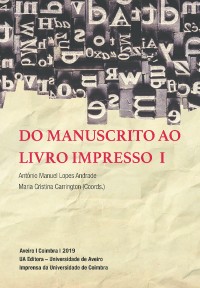Please use this identifier to cite or link to this item:
https://hdl.handle.net/10316.2/46163| Title: | O advento da tipografia e a nova circulação da informação | Other Titles: | The art of printing and the new circulation of information | Authors: | Pericão, Maria da Graça | Keywords: | History of Book;Typography;Circulation of Information;Art of Printing;Incunable;História do Livro;Tipografia;Circulação da Informação;Invenção da Imprensa;Incunábulo | Issue Date: | 2019 | Publisher: | Imprensa da Universidade de Coimbra UA Editora - Universidade de Aveiro |
Journal: | http://hdl.handle.net/10316.2/46162 | Abstract: | Since the medieval times, one enhances the work of the monks in their monasteries providing the transmission and preservation of knowledge of Antiquity until the birth of the new technology – the Art of printing. The long and hard way from the wood‑block printing towards the movable type and incunabula in which Gutenberg and his companions had a decisive role is referred, as well as the advantages of the new process of production of texts. The teaching of scientific subjects at the universities was crucial, bringing a new audience, the scholars, avid of multiple and original texts. Other advantages of printing are the reduction of price as well as the rapidity of production and, above all, the fixation of the text itself, avoiding the errors that could be introduced at any stage of the manual copy. The circulation of information could, hereafter, and straight through the common language – the Latin language – cross borders and reach the cultural European world. Procura dar‑se uma ideia de como a descoberta da Arte tipográfica veio alterar a circulação da informação a partir do momento em que foi inventada. Salienta‑se o papel que a Igreja até então desempenhara na preservação e transmissão da cultura da Antiguidade através dos scriptoria monásticos. Aborda‑se a crescente procura de textos por parte dos estudiosos, sobretudo devida ao aparecimento de novas universidades, exigindo uma tecnologia que permitisse uma mais rápida produção de textos. Essa tecnologia irá aparecer no momento certo, tímida de início, marcada por avanços e recuos, mas em meados do século XV é descoberto o processo que não mais cessará de aperfeiçoar‑se, evidenciando‑se o papel que Gutenberg desempenhou nessa pesquisa. As vantagens da nova tecnologia revelar‑se‑iam em breve, permitindo uma maior rapidez de produção, um custo bem menor e, sobretudo, a fixação do texto, evitando os frequentes erros da cópia manuscrita e a corrupção dos textos. Alude‑se ainda ao papel desempenhado pelo veículo da cultura – a língua latina – que permitirá intensificar ainda mais a circulação da informação. Por fim, refere‑se o caso do Mosteiro de Santa Cruz de Coimbra, reputado centro de cópias manuscritas e que, nos anos 30 do século XVI, se vai “converter” à nova tecnologia. |
URI: | https://hdl.handle.net/10316.2/46163 | ISBN: | 978-989-26-1711-4 (PDF) 978-989-26-1710-7 |
DOI: | 10.14195/978-989-26-1711-4_1 | Rights: | open access |
| Appears in Collections: | Do manuscrito ao livro impresso I |
Files in This Item:
| File | Description | Size | Format | |
|---|---|---|---|---|
| o_advento_da_tipografia.pdf | 3.03 MB | Adobe PDF |  |
Items in DSpace are protected by copyright, with all rights reserved, unless otherwise indicated.
